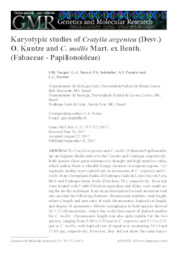Karyotypic studies of Cratylia argentea (Desv.) O. Kuntze and C. mollis Mart. ex Benth. (Fabaceae - Papilionoideae).
Karyotypic studies of Cratylia argentea (Desv.) O. Kuntze and C. mollis Mart. ex Benth. (Fabaceae - Papilionoideae).
Author(s): VARGAS, S. M.; TORRES, G. A.; SOUZA SOBRINHO, F.; PEREIRA, A. V.; DAVIDE, L. C.
Summary: Cratylia argentea and C. mollis (Fabaceae-Papilionoideae) are legume shrubs native to the Cerrado and Caatinga, respectively. Both species show great resistance to drought and high nutritive value, which makes them a valuable forage resource in tropical regions. Cytogenetic studies were carried out on accessions of C. argentea and C. mollis from Germplasm Banks of Embrapa Gado de Leite (Juiz de Fora, MG) and Embrapa Semi-Árido (Petrolina, PE), respectively. Root tips were treated with 3 mM 8-hydroxyquinoline and slides were made using the air-dry technique. Karyotype description for each accession took into account the following features: chromosome number; total length, relative length and arm ratio of each chromosome; haploid set length, and degree of asymmetry. Mitotic metaphases in both species showed 2n = 22 chromosomes, where this is the first report of diploid number for C. mollis. Chromosome length was also quite similar for the two species, ranging from 5.08 to 2.50 µm in C. argentea and 5.12 to 2.51 µm in C. mollis, with haploid sets of equal size, measuring 38.10 and 37.85 µm, respectively. However, they did not show the same karyotypic formula, which was 5 m + 4 sm + 2 st for C. argentea and 7 m + 2 sm + 2 st for C. mollis. This indicates the occurrence of rearrangements within chromosomes I and VI. Both karyotypes showed a tendency for asymmetry.
Publication year: 2007
Types of publication: Journal article
Unit: Embrapa Dairy Cattle
Observation
Some of Embrapa's publications are published as ePub files. To read them, use or download one of the following free software options to your computer or mobile device. Android: Google Play Books; IOS: iBooks; Windows and Linux: Calibre.
Access other publications
Access the Agricultural Research Database (BDPA) to consult Embrapa's full library collection and records.
Visit Embrapa Bookstore to purchase books and other publications sold by Embrapa.

